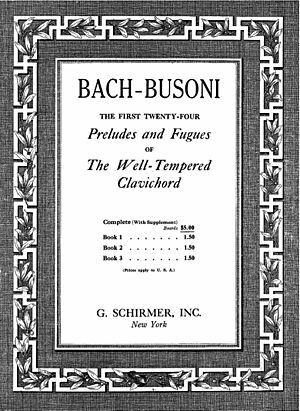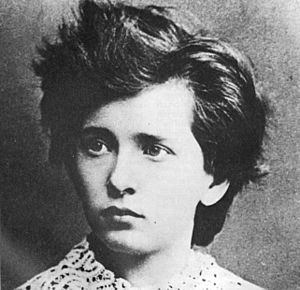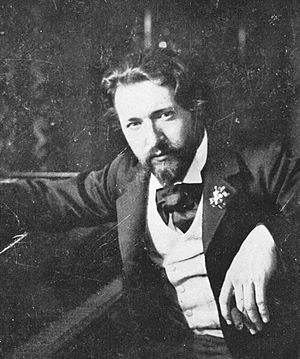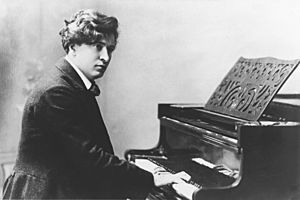Ferruccio Busoni facts for kids
Ferruccio Busoni (born April 1, 1866 – died July 27, 1924) was a talented Italian composer, pianist, and conductor. He was also a writer, editor, and teacher. His work took him all over the world, and he collaborated with many famous musicians and artists of his time. He was a popular teacher for both piano and composition.
Busoni was an amazing pianist from a young age. He studied music in Vienna and later with Wilhelm Mayer and Carl Reinecke. After teaching for short times in Helsinki, Boston, and Moscow, he focused on composing, teaching, and performing as a piano expert in Europe and the United States. His writings about music were very important. They covered ideas about beauty in music and even new concepts like microtones (tiny notes between regular ones). From 1894, he lived in Berlin, but he spent much of World War I in Switzerland.
He started composing in a late Romantic style. But after 1907, when he wrote Sketch of a New Esthetic of Music, he developed his own unique style. This new style often included parts of atonality, which means music without a clear main key. His trips to America made him interested in Native American tribal melodies. He used these melodies in some of his works. His compositions include pieces for piano, like a huge Piano Concerto. He also rewrote works by other composers, especially Johann Sebastian Bach (published as the Bach-Busoni Editions). He wrote chamber music (for small groups), vocal and orchestral pieces, and operas. One of his operas, Doktor Faust, was not finished when he died in Berlin at age 58.
Contents
Biography: Ferruccio Busoni's Life Story
Early Life and Musical Beginnings
Ferruccio Dante Michelangiolo Benvenuto Busoni was born on April 1, 1866, in Empoli, Italy. He was the only child of two musicians. His father, Ferdinando, played the clarinet, and his mother, Anna, was a pianist. Soon after he was born, his family moved to Trieste.
Busoni was a child prodigy, meaning he was incredibly talented from a very young age. His father taught him most of what he knew. He started performing and composing when he was just seven years old. Busoni later said that his father was very strict and energetic in his teaching.
He gave his first public piano concert in Trieste on November 24, 1873. He played music by Mozart, Schumann, and Clementi. His parents promoted his concerts, and Busoni later said he "never had a childhood" because of all the performing. In 1875, he played his first concerto, Mozart's Piano Concerto No. 24.
From ages nine to eleven, Busoni studied at the Vienna Conservatory. Critics loved his first performances in Vienna. In 1877, Busoni heard the famous pianist Franz Liszt play. He even met Liszt, who was impressed by his skills. The next year, Busoni composed a four-movement concerto for piano and string quartet. After Vienna, he studied briefly in Graz and conducted his own piece, Stabat Mater, in 1879.
In 1881, he became the youngest person to join the Accademia Filharmonica of Bologna since Mozart. In the mid-1880s, Busoni lived in Vienna. He met Karl Goldmark and helped him prepare his opera Merlin. He also met Johannes Brahms, to whom he dedicated some piano studies. Brahms suggested he study in Leipzig with Carl Reinecke. During this time, Busoni supported himself by giving concerts and with help from a patron. He also kept composing and started an opera called Sigune, but he never finished it.
Teaching and Traveling: Helsinki, Moscow, and America
In 1888, Busoni got his first steady job as an advanced piano instructor at the Institute of Music in Helsingfors (now Helsinki, Finland). There, he became friends with composer Jean Sibelius.
Between 1888 and 1890, Busoni gave about thirty piano concerts in Helsingfors. He also composed some Finnish folk songs for piano duet. In 1889, he heard Bach's Toccata and Fugue in D minor on the organ. He was convinced to rewrite it for piano. This was the start of his famous Bach transcriptions and his unique piano playing style. In March of that year, Busoni met Gerda Sjöstrand, who would become his wife. He proposed to her within a week!
In 1890, Busoni published his first edition of Bach's works. He also won a prize for his composition Konzertstück for piano and orchestra. This led to an invitation to teach at the Moscow Conservatoire. Gerda joined him in Moscow, and they got married. His first concert in Moscow was well-received. However, Busoni didn't like living in Moscow. So, when he was offered a teaching job at the New England Conservatory of Music in Boston, he gladly accepted.
Busoni's first son, Benvenuto (called Benni), was born in Boston in 1892. But Busoni found his experience at the New England Conservatory disappointing. After a year, he left and started giving concerts across the Eastern United States.
Berlin: A New Artistic Era
In April 1893, Busoni saw the Berlin premiere of Giuseppe Verdi's opera Falstaff. This opera made him rethink Italian music, which he had mostly ignored before. He felt it was the start of "a new epoch" in his artistic life.
In 1894, Busoni settled in Berlin, which became his main home. He had disliked the city before, calling it "irritating" and "arrogant." However, Berlin was growing into a major music center. It became a great base for Busoni's tours across Europe. He relied on these tours to earn a living, as he was a famous piano expert. He also sent money to his parents.
Busoni's concerts sometimes surprised people. In London in 1897, critics had mixed feelings. Some found his version of a Bach organ piece "ridiculous." But they praised his playing of Chopin's studies. In Paris, a critic liked his technique but didn't like his changes to Liszt's music.
Busoni's international fame grew quickly. He performed often in Berlin and other European cities. He also returned to America four times between 1904 and 1915. This constant travel led one friend to call him "a musical Ishmael" (a wanderer).
His performing schedule limited his time for composing. In 1896, he wrote, "I have great success as a pianist, the composer I conceal for the present." His huge Piano Concerto, which lasts over an hour, was written between 1901 and 1904. In 1904 and 1905, he wrote his Turandot Suite as music for a play. He also started a major opera, Die Brautwahl, which was first performed in Berlin in 1912. Busoni also began writing piano pieces in a more mature style, like the Elegies (1907).
Between 1902 and 1909, Busoni conducted orchestral concerts in Berlin. He especially promoted new music from outside Germany. These concerts included first German performances of music by Edward Elgar, Sibelius, Claude Debussy, and Béla Bartók. He also included some of his own works, like the Piano Concerto. These concerts got a lot of attention but also strong criticism.
Busoni also taught masterclasses in Weimar, Vienna, and Basel. He preferred these to formal conservatory teaching. His students included Maud Allan, who became a famous dancer.
Before World War I, Busoni connected with many artists beyond musicians. He corresponded with Arnold Schoenberg and helped him settle in Berlin. In 1913, Busoni hosted a private performance of Schoenberg's Pierrot lunaire at his home. He also met with Futurist artists like Filippo Tommaso Marinetti in Paris.
World War I and Switzerland

In 1913, Busoni was offered the directorship of the Liceo Rossini in Bologna, Italy. He took the job, planning to spend summers in Berlin. But the job was not successful. Bologna was not a very active cultural city, and Busoni had problems with the local authorities.
When World War I started in August 1914, Busoni was not too worried at first because Italy was a neutral country. He began working on the story for his opera Doktor Faust. In January 1915, he left for a concert tour in the US, which was his last visit there. While in America, he continued working on his Bach editions.
When he returned to Europe, Italy had joined the war. So, Busoni decided to live in Switzerland from 1915. In Zurich, he found supporters and friends. His friend Philipp Jarnach became his important assistant. While in America, Busoni had also written the story for his one-act opera Arlecchino. He finished it in Zurich and also turned his earlier Turandot music into a one-act opera. Both operas premiered together in Zurich in May 1917.
Busoni continued to experiment with microtones, which are musical intervals smaller than a semitone. He claimed to have developed a system for using "thirds of tones."
Although he met many other artists in Switzerland during the war, Busoni soon felt limited. After the war ended, he started concert tours again in England, Paris, and Italy. When his former student Leo Kestenberg invited him back to Germany with a teaching job, Busoni was happy to return.
Final Years and Legacy
In 1920, Busoni returned to his apartment in Berlin. His health began to get worse, but he still gave concerts. His main goal was to finish Doktor Faust. He wrote in 1921 that the music for Faust was constantly flowing in his mind.
Berlin was a very important musical city at this time. Busoni's works were often performed. He continued to perform when his health allowed. His last performance as a pianist was in Berlin in May 1922, playing Beethoven's Emperor Concerto. Among his composition students in Berlin were Kurt Weill and Wladimir Vogel.
Busoni died in Berlin on July 27, 1924, at age 58. The official cause was heart failure, but kidney problems and overwork also contributed. Doktor Faust was unfinished when he died. His student Philipp Jarnach completed it, and it premiered in Berlin in 1925. Busoni's Berlin apartment was destroyed in a bombing in 1943, and many of his belongings were lost. A plaque now marks the site where he lived.
Busoni's Music and Style
His Piano Playing Style
The famous pianist Alfred Brendel said that Busoni's playing showed "the victory of reflection over bravura" (flashy skill). Busoni himself believed that music should always be surprising and inventive. He felt that the "spirit of music" comes from deep within us.
Some people were surprised by Busoni's playing. For example, Sir Henry Wood heard him play parts of a Mozart concerto with two hands in double octaves, even though the music was written for single notes. Music experts said that Busoni was being true to Mozart's spirit, as Mozart himself might have taken similar freedoms. The musicologist Percy Scholes called Busoni "the truest artist" among pianists he had heard.
His Compositions
Busoni's works include his own compositions, as well as his versions of other composers' music.
Understanding His Works
Busoni gave many of his works opus numbers. Sometimes, one number applied to more than one piece. A music expert named Jürgen Kindermann created a catalog of Busoni's works. These are identified by the letters BV (for Busoni Verzeichnis, meaning "Busoni Index") followed by a number. For example, BV 244 is his Second Violin Sonata.
Early Works and New Directions
Busoni wrote over 200 compositions before 1900. Most of these were for piano, either solo or with other instruments. He also wrote some chamber music and orchestral works.
After 1900, Busoni started to develop his own unique style. The first important pieces in this new style were piano works published between 1907 and 1912. These included the Elegies and the first two piano sonatinas. His Fantasia contrappuntistica (1910) is a large work for solo piano, lasting about half an hour. It is based on an unfinished fugue by Bach and uses several of Bach's musical ideas.
Busoni also found inspiration in American Indian tribal melodies. He used these in his Indian Fantasy for piano and orchestra (1913) and in two books of piano sketches called Indian Diary. In 1917, Busoni wrote the one-act opera Arlecchino and revised Turandot into an opera. He began serious work on his opera Doktor Faust in 1916, but it was unfinished when he died. His student Philipp Jarnach completed it.
Busoni's Work with Bach's Music

In 1894, Busoni published the first part of his edition of Johann Sebastian Bach's music for piano. This included the first book of The Well-Tempered Clavier. This was part of the Bach-Busoni Edition, a project that lasted over thirty years. Busoni also started publishing his concert piano transcriptions of Bach's music, which he often played in his own concerts. These included some of Bach's organ pieces, like the famous Toccata and Fugue in D minor.
These transcriptions were more than just copying the music for piano. Busoni often added his own ideas, like tempo markings and dynamics. He believed that the performer should be free to understand and share the composer's intentions. For example, in his edition of Bach's Goldberg Variations, he suggested cutting some variations for a concert performance and rewrote many sections.
His Writings on Music
Busoni wrote several essays about music. His most famous is Entwurf einer neuen Ästhetik der Tonkunst (Sketch of a New Esthetic of Music), first published in 1907. In this book, he explained his ideas about performing and composing. He believed that while the "spirit of an artwork" stays the same, its form and style can change over time. He famously said, "Music was born free; and to win freedom is its destiny."
He argued against strict rules in music and praised the music of Beethoven and Bach as the true "spirit of music." Busoni believed that performers should have the freedom to interpret music. He also imagined a future music that would use more than the traditional 12 semitones in an octave.
Another collection of his essays was published in 1922 as Von der Einheit der Musik (The Essence of Music). Busoni also wrote the stories for his four operas.
Editions and Arrangements
Besides Bach, Busoni also edited and arranged works by other composers. He edited three volumes of Franz Liszt's works, including many of his studies. He also made piano arrangements of Liszt's organ pieces.
Busoni also created piano transcriptions of works by Mozart, Franz Schubert, and others. Later, he made a "concert interpretation" of Arnold Schoenberg's atonal Piano Piece, Op. 11, No. 2. Busoni sometimes used parts of other composers' music in his own works. For example, his Piano Sonatina No. 6 (1920) is based on themes from Georges Bizet's opera Carmen.
Recordings of Busoni's Playing
Busoni made very few gramophone recordings as a pianist. Many of his original recordings were destroyed in a fire. He never recorded any of his own compositions.
Piano Rolls
Busoni made many piano rolls. These are rolls of paper with holes that can play a piano automatically. Some of these have been re-recorded and released on vinyl and CD. However, many of his students and colleagues were disappointed with these recordings. They felt the piano rolls did not truly capture Busoni's unique playing style.
For example, his student Egon Petri said the piano roll recordings were a "travesty" of Busoni's playing. Another student, Gunnar Johansen, said that only one of the recordings, Liszt's Feux follets, was truly unique, and the rest were "curiously unconvincing."
Busoni's Lasting Impact
Busoni's influence on music came more from his teaching and his writings than from his compositions themselves. There aren't many composers who directly followed his style. Alfred Brendel, a famous pianist, believes that Busoni's later piano music, like his first two sonatinas and the Toccata of 1921, are still very important and perhaps not fully appreciated. His opera Doktor Faust is also seen as a towering work in musical theater.
Helmut Wirth, a music expert, wrote that Busoni's "ambivalent nature" (meaning he tried to combine old traditions with new ideas) and his deep theoretical writings make him "one of the most interesting figures in the history of 20th-century music."
The Ferruccio Busoni International Piano Competition was started in his honor in 1949, to celebrate 25 years since his death.
|
See also
 In Spanish: Ferruccio Busoni para niños
In Spanish: Ferruccio Busoni para niños








